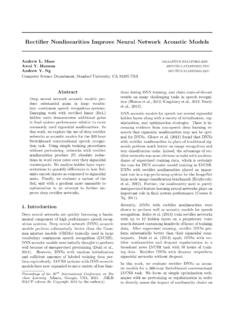Unit Recognition With Sparse Representation
Found 9 free book(s)BENGALURU CITY UNIYERSITY
bcu.ac.inJan 04, 2022 · Arrays: Definition, Linear arrays, arrays as ADT, Representation of Linear Arrays in Memory,Traversing Linear arrays, Inserting and deleting, Multi-dimensional arrays, Matrices and Sparse matrices. UNIT-II [12 Hours] Linked list: Definition, Representation of Singly Linked List in memory,Traversing a Singly linked list,
Multimodal Deep Learning - ai.stanford.edu
ai.stanford.edutive shared representation learning. 1. Introduction In speech recognition, humans are known to inte-grate audio-visual information in order to understand speech. This was rst exempli ed in the McGurk ef-fect (McGurk & MacDonald,1976) where a visual /ga/ with a voiced /ba/ is perceived as /da/ by most sub-jects.
Michael D. Moffitt Qi Song, Jie Li, Chenghong Li, Hao Guo ...
aaai.org517: SCIR-Net: Structured Color Image Representation Based 3D Object Detection Network from Point Clouds Qingdong He, Hao Zeng, Yi Zeng, Yijun Liu 521: Memory-Based Jitter: Improving Visual Recognition on Long-Tailed Data with Diversity In …
ShuffleNet: An Extremely Efficient Convolutional Neural ...
openaccess.thecvf.comunit [9] in Fig 2 (a). It is a residual block. In its residual branch, for the 3 ×3 layer, we apply a computational eco-nomical 3 ×3 depthwise convolution [3] on the bottleneck feature map. Then, we replace the first 1 ×1 layer with pointwise group convolution followed by a channel shuffle operation, to form a ShuffleNet unit, as shown in ...
fzhangxiangyu,zxy,linmengxiao,sunjiang@megvii.com arXiv ...
arxiv.orgunit [9] in Fig2(a). It is a residual block. In its residual branch, for the 3 3 layer, we apply a computational eco-nomical 3 3 depthwise convolution [3] on the bottleneck feature map. Then, we replace the first 1 1 layer with pointwise group convolution followed by a channel shuffle operation, to form a ShuffleNet unit, as shown in Fig2(b).
arXiv:1408.5882v2 [cs.CL] 3 Sep 2014
arxiv.orgsparse, 1-of-V encoding (here V is the vocabulary size) onto a lower dimensional vector space via a hidden layer, are essentially feature extractors that encode semantic features of words in their dimen-sions. In such dense representations, semantically close words are likewise close—in euclidean or cosine distance—in the lower dimensional ...
Sparse autoencoder - Stanford University
web.stanford.eduSparse autoencoder 1 Introduction Supervised learning is one of the most powerful tools of AI, and has led to automatic zip code recognition, speech recognition, self-driving cars, and a continually improving understanding of the human genome. Despite its sig-nificant successes, supervised learning today is still severely limited. Specifi-
Recti er Nonlinearities Improve Neural Network Acoustic Models
ai.stanford.eduhidden unit’s activation h(i) is given by, h(i) = ˙(w(i)T x); (1) where ˙( ) is the tanh function, w(i) is the weight vec-tor for the ith hidden unit, and xis the input. The input is speech features in the rst hidden layer, and hidden activations from the previous layer in deeper layers of the DNN.
Introduction to Deep Learning - Stanford University
graphics.stanford.eduConvolutional Networks for Large-Scale Image Recognition. Its main contribution was in showing that the depth of the network is a critical component for good performance. Their final best network contains 16 CONV/FC layers and, appealingly, features an extremely homogeneous architecture that only performs 3x3 convolutions and 2x2





![arXiv:1408.5882v2 [cs.CL] 3 Sep 2014](/cache/preview/2/c/b/c/4/4/d/0/thumb-2cbc44d022447f6e8ab127ee8a6e3bd2.jpg)


